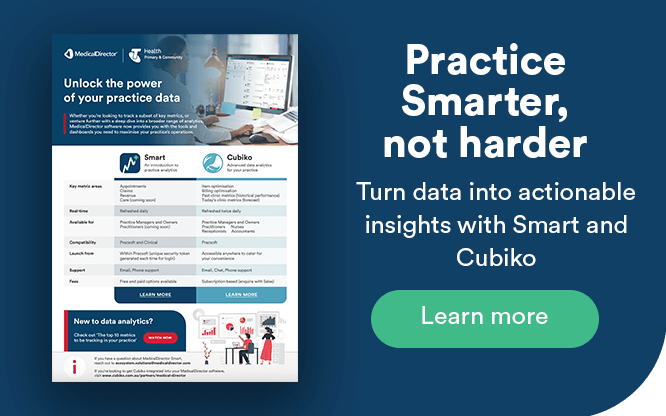Why it’s time to take the fear factor out of collaborative care
Despite ample research showing the benefits of team-based and collaborative care to enable better patient outcomes, there’s still a ‘fear factor’ around adoption in the healthcare community. Digital health, practice management and medical software expert, Katrina Otto, discusses.
What is collaborative care?
Collaborative care, or team-based care, promotes an environment where healthcare professionals can communicate, co-operate and collaborate efficiently, often in real-time, to enable better health outcomes for patients.
What are the benefits of collaborative care?
According to MedicalDirector’s whitepaper Interoperability in healthcare: Synergising an industry, effective collaboration, when achieved within a system that supports interoperability, can enable more timely and accurate health outcomes, by breaking down the traditional communication ‘silos’ to uncover a more efficient and connected approach to care. At the same time, team-based care promotes better quality of care, enhanced patient safety and overall better patient experience.
Importantly, the report found collaborative healthcare could improve both the experience of the patient and the experience of delivering care for healthcare practitioners. The report suggested it could also help to reduce hospital admissions, curb unnecessary expenditure and alleviate pressure on an already burdened system.
“It’s all about supporting doctors and GPs to allow them to focus on delivering patient-centric care in the best possible way,” Katrina explains. “If we’re serious about improving patient outcomes, we need to support GPs and embrace a more team-based model of care.”
Fear and anxiety in times of change
Despite the benefits of collaborative care, Katrina highlights that the current changing healthcare landscape is instilling fear and anxiety within the health community around the implications of a team-based approach.
“With all the changes to the MBS, the Medicare Freeze, changes in Government and the underfunding of primary care, there’s a constant feeling of a ‘struggle to survive,’” Katrina explains. “And given the shifting landscape with primary care, what’s happening is there’s a feeling within the healthcare community that we’re looking to the UK and the US models as models to potentially replicate – and both are fraught with issues. So every time the issue of collaborative care is raised, understandably, it’s met with resistance and fear.”
According to Katrina, this the very idea can be really scary for some GPs and nurses, especially if they feel their job is at risk.
“At the moment, the role of nurse practitioners is changing, and some doctors are afraid they’ll take their jobs,” she says. “Meanwhile medical practice assistants (MPAs) are on the rise and some nurses are worried these assistants are moving into a clinical space where they do not belong”
The mindshift towards collaborative care
But instead of being fearful about different ways of working, Katrina says it’s important the health community has a mindshift and see collaborative care for what it really is – creating a supportive environment.
“It’s all about creating support for the doctor, and team-based care should be seen as surrounding the doctor with support – so doctors can do what doctors do best,” Katrina says. “We can’t expect the government to throw more money at primary care. Instead, let’s focus on a support team surrounding the patients, nurses and doctors”
Encouraging a culture of collaborative care within a clinical setting can start with firstly, accepting and embracing the role of the MPA, Katrina says.
“Rather than nurses feeling threatened by the role of an MPA, think of how the assistant could be an opportunity to make some real time-saving, positive changes,” she explains. “The majority of effective practices I see look to MPAs as an assistant to the nurse, so the nurse doesn’t have to do the restocking, or measure the height and weight of patients. They are qualified so have skills in effective triaging and can save valuable time for the nurse.
“So instead of everyone being overwhelmed and having to hang onto all those tasks they really could delegate to others, everyone can work to the top of their scope. I am big believer in doctors doing what only doctors can do and what I also see is nurses ready and willing to do more. If we support with some of the easier tasks then everyone is working to their scope of practice. Now to me, that’s what makes a high performing, collaborative practice.”
Technology and taking small steps
But overcoming the fear of change within primary isn’t something that happens overnight, and Katrina suggests practices can start taking small steps, to just see it in different ways.
“Good quality training and developing trust in the team is a great start,” she says. “If the nurse trusts the MPA to undertake specified tasks, and if the doctor trusts the nurse to do more things, already the more team-based culture will be set up to embrace change. I see this working well in some of our Health Care Home trial practices.”
According to Katrina, effective use of electronic health records (EHRs) is essential to facilitate that collaborative care and to help these roles follow on from each other.
“Because if that information isn’t used well or coded in the right place, for example, a medication or diagnosis, that’s going to effect the performance of the team,” she explains. “That’s where technology can make a significant difference.”
“Leveraging shared health records like the electronic health record in MedicalDirector’s clinical and practice management software, as well as MedicalDirector’s integration with other tools such as My Health Record and secure messaging vendors, means we have a very effective tool that enables improved sharing with the team, paving the way to more efficient and supportive collaborative care.”










